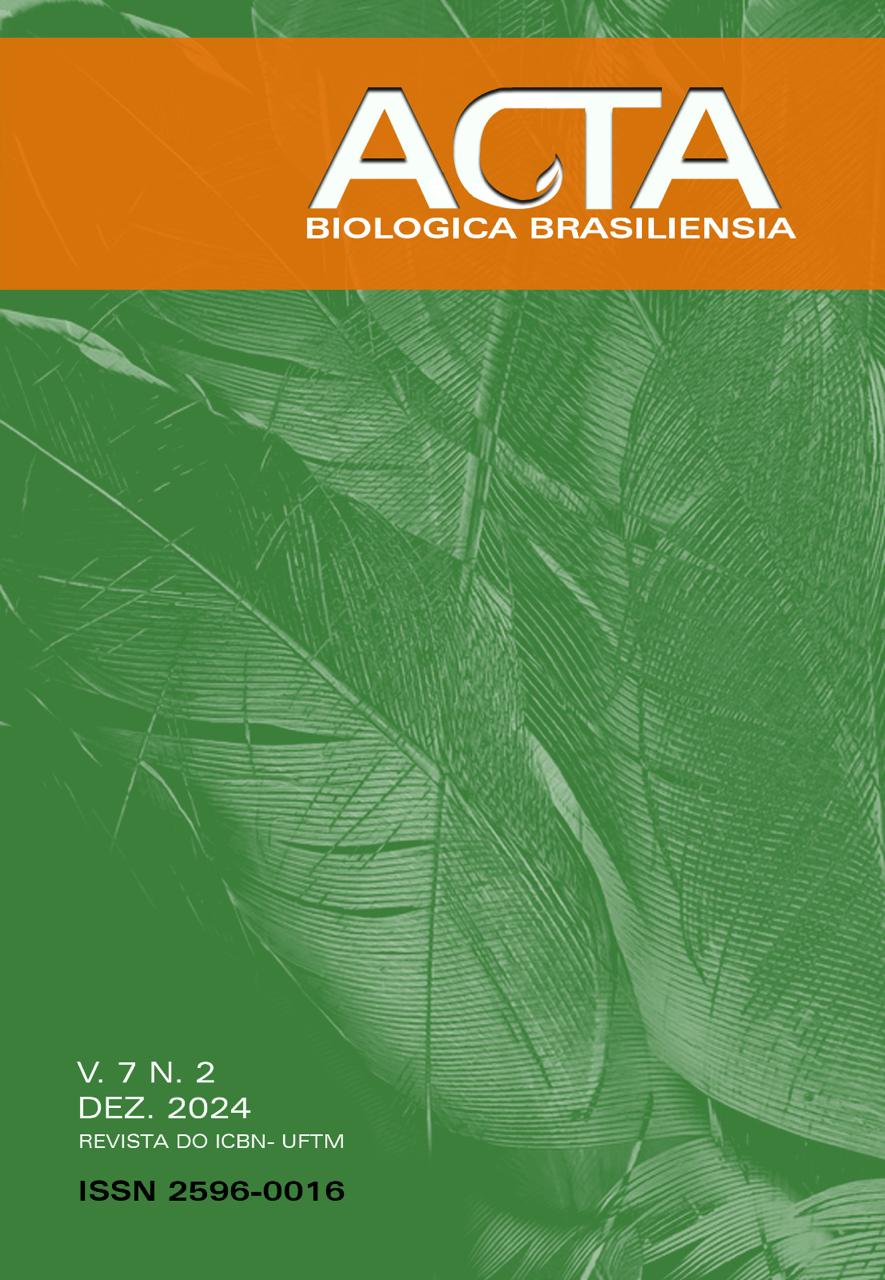EXPANSION OF TRINUCLEOTIDE REPEATS IN HUMAN DNA AND MOLECULAR DIAGNOSIS OF TRINUCLEOTIDE EXPANSION DISORDERS: INTEGRATIVE REVIEW
Molecular diagnosis of TNR expansion disorders
DOI:
https://doi.org/10.18554/acbiobras.v7i2.8007Palavras-chave:
Trinucleotide expansions, DNA sequencing, Molecular Biology, Molecular Diagnostics, GeneticsResumo
Trinucleotide repeat (TNR) expansions are increases in the number of repeated trinucleotides in the genome. TNR expansions have been confirmed as the molecular etiology of various neurodegenerative disorders, such as Huntington's Disease, Fragile X Syndrome, and Friedreich's Ataxia. Due to the potential achieved by molecular diagnostic technology, new disorders related to TNR expansions are being elucidated more rapidly, as high-throughput technologies for analyzing DNA are described every year. Thus, we carried out an integrative review on the importance of improving DNA analysis methods for the molecular diagnosis of diseases related to TNR expansions. We searched the PubMed using the descriptors "trinucleotide expansion", "DNA analysis", "genome" and "DNA sequencing". In our review, 42 genomic targets were identified as being responsible for diseases related to TNR expansions, with one target being related to two diseases and two targets being related to three diseases. The rest of the targets are related to a single disease. Despite the emergence of new sequencing technologies, PCR-based techniques continue to play an important role in identifying targets related to diseases caused by TNR expansions. New DNA sequencing technologies have demonstrated an important contribution to the identification of targets related to diseases caused by TNR, especially since 2019. The development of novel DNA analysis techniques and new genomic analysis tools has the potential to unveil novel targets associated with TNR expansions.
Referências
Nurk S, Koren S, Rhie A, Rautiainen M, Bzikadze AV, Mikheenko A, Vollger MR, Altemose N, Uralsky L, Gershman A, et al. The complete sequence of a human genome. Science. 2022; 376(6588):44-53. https://doi.org/10.1126/science.abj6987.
Liehr T. Repetitive Elements in Humans. Int J Mol Sci. 2021; 22(4):2072. https://doi.org/10.3390/ijms22042072.
Carpenter NJ. Genetic anticipation. Expanding tandem repeats. Neurol Clin. 1994; 12(4):683-97. https://doi.org/10.1016/S0733-8619(18)30071-9.
Yau WY, O'Connor E, Sullivan R, Akijian L, Wood NW. DNA repair in trinucleotide repeat ataxias. FEBS J. 2018; 285(19):3669-3682. https://doi.org/10.1111/febs.14644.
Depienne C, Mandel JL. 30 years of repeat expansion disorders: What have we learned and what are the remaining challenges? Am J Hum Genet. 2021; 108(5):764-785. https://doi.org/10.1016/j.ajhg.2021.03.011.
Tan D, Wei C, Chen Z, Huang Y, Deng J, Li J, Liu Y, Bao X, Xu J, Hu Z, et al. CAG Repeat Expansion in THAP11 Is Associated with a Novel Spinocerebellar Ataxia. Mov Disord. 2023; 38(7):1282-1293. https://doi.org/10.1002/mds.29412.
Bates GP, Dorsey R, Gusella JF, Hayden MR, Kay C, Leavitt BR, Nance M, Ross CA, Scahill RI, Wetzel R, Wild EJ, Tabrizi SJ. Huntington disease. Nat Rev Dis Primers. 2015; 1:15005. https://doi.org/10.1038/nrdp.2015.5.
Scherzinger E, Lurz R, Turmaine M, Mangiarini L, Hollenbach B, Hasenbank R, Bates GP, Davies SW, Lehrach H, Wanker EE. Huntingtin-encoded polyglutamine expansions form amyloid-like protein aggregates in vitro and in vivo. Cell. 1997; 90(3):549-58. https://doi.org/10.1016/s0092-8674(00)80514-0.
Liu Q, Pan Y, Li XJ, Li S. Molecular Mechanisms and Therapeutics for SCA17. Neurotherapeutics. 2019; 16(4):1097-1105. https://doi.org/10.1007/s13311-019-00762-z.
Figueiredo AS, Loureiro JR, Macedo-Ribeiro S, Silveira I. Advances in Nucleotide Repeat Expansion Diseases: Transcription Gets in Phase. Cells. 2023; 12(6):826. https://doi.org/10.3390/cells12060826.
Ravache M, Abou-Sleymane G, Trottier Y. Les maladies neurodégénératives par expansion de polyglutamine: physiopathologie et stratégies thérapeutiques [Neurodegenerative polyglutamine expansion diseases: physiopathology and therapeutic strategies]. Pathol Biol. 2010; 58(5):357-66. French. https://doi.org/10.1016/j.patbio.2009.12.004.
Olejniczak M, Urbanek MO, Krzyzosiak WJ. The role of the immune system in triplet repeat expansion diseases. Mediators Inflamm. 2015; 2015:873860. https://doi.org/10.1155/2015/873860.
Fujino Y, Nagai Y. The molecular pathogenesis of repeat expansion diseases. Biochem Soc Trans. 2022; 50(1):119-134. https://doi.org/10.1042/BST20200143.
Zhou ZD, Jankovic J, Ashizawa T, Tan EK. Neurodegenerative diseases associated with non-coding CGG tandem repeat expansions. Nat Rev Neurol. 2022; 18(3):145-157. https://doi.org/10.1038/s41582-021-00612-7.
Thompson LM, Orr HT. HD and SCA1: Tales from two 30-year journeys since gene discovery. Neuron. 2023; 111(22):3517-3530. https://doi.org/10.1016/j.neuron.2023.09.036.
Lee LKC, Leong LI, Liu Y, Luo M, Chan HYE, Choi CHJ. Preclinical Nanomedicines for Polyglutamine-Based Neurodegenerative Diseases. Mol Pharm. 2021; 18(2):610-626. https://doi.org/10.1021/acs.molpharmaceut.0c00506.
Jones L, Houlden H, Tabrizi SJ. DNA repair in the trinucleotide repeat disorders. Lancet Neurol. 2017; 16(1):88-96. https://doi.org/10.1016/S1474-4422(16)30350-7.
Verkerk AJ, Pieretti M, Sutcliffe JS, Fu YH, Kuhl DP, Pizzuti A, Reiner O, Richards S, Victoria MF, Zhang FP, et al. Identification of a gene (FMR-1) containing a CGG repeat coincident with a breakpoint cluster region exhibiting length variation in fragile X syndrome. Cell. 1991; 65(5):905-14. https://doi.org/10.1016/0092-8674(91)90397-h.
Harris RA, Raveendran M, Worley KC, Rogers J. Unusual sequence characteristics of human chromosome 19 are conserved across 11 nonhuman primates. BMC Evol Biol. 2020; 20(1):33. https://doi.org/10.1186/s12862-020-1595-9.







